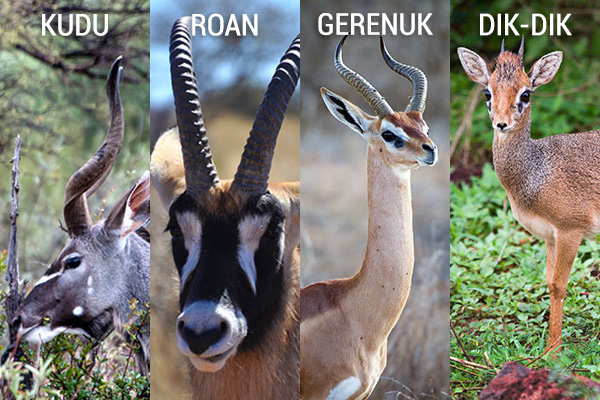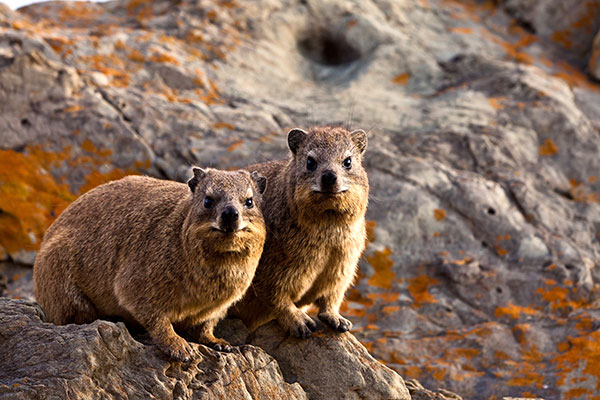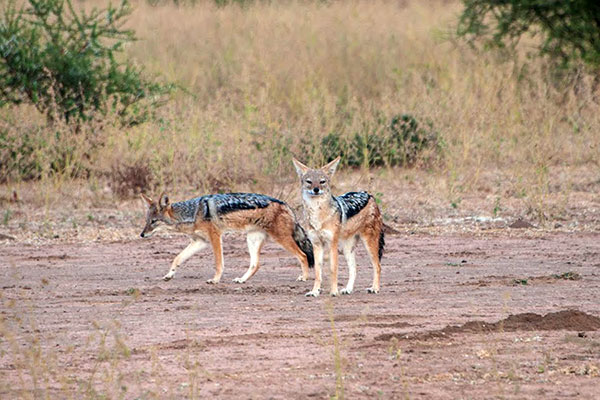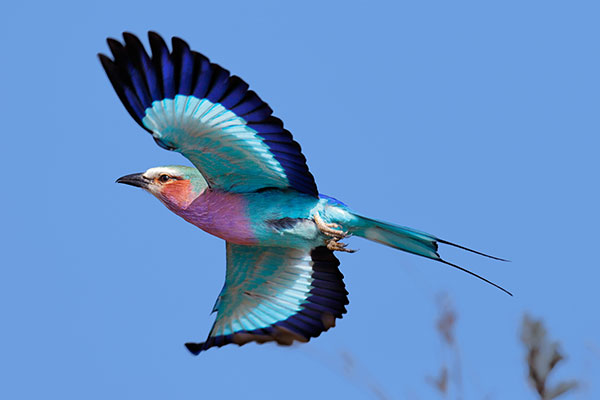African Wildlife Safari: The Creatures of Kenya and Tanzania
Most people going on an African wildlife safari want to see the Big 5 of Africa, but it’s a common misconception that the big animals are always the most exciting to see on safari. The ecosystems of Kenya and Tanzania are extremely complex. Every animal, from the largest elephant to the smallest insect, plays an important role.
Many people return from safari with a new favorite animal they had never heard of before. Here are just a few of our favorite underrated animals you can find in Kenya and Tanzania.
Interesting Antelope

Kudu and roan photos courtesy of Candice and Paul Heckel
There are a huge variety of antelopes on the plains of the Serengeti, the Maasai Mara, and beyond. The kudu is distinctive with its beautiful corkscrew horns. The sable, with its dramatic facial markings and long, curved antlers, is the “pretty boy” of the savannah. The gerenuk, also known as a giraffe gazelle, has a strangely long and elegant neck. They look very odd when they stand and stretch to reach their food! The dik-dik is one of the smallest antelopes in Africa, but don’t let their cuteness fool you—these little guys are feisty!
These are just a few of the antelope species you’ll find in Kenya and Tanzania. While on safari, your expert guide will help you identify many others.
Rock Hyrax

This adorable animal can be found in many areas of Africa and the Middle East. Their sticky, suction cup-like feet help them climb on inhospitable cliff faces. Rock hyraxes live in large colonies and spend about 95% of the day resting, often piling on top of each other in a massive cuddle session. They are also very vocal creatures; you’ll hear their strange songs as they call to each other in the wild. While the rock hyrax may look like a guinea pig or other type of rodent, it is actually related to elephants and manatees.
Black-Backed Jackal

Photo courtesy of Candice and Paul Heckel
The black-backed jackal—named for the distinctive swath of black and silver fur on its back—is a hunter and scavenger that lives in the plains of Kenya and Tanzania. They will hunt small rodents and lizards, and sometimes team up to take down larger prey. They also steal food from lions or hyenas when they can. During plentiful times, these jackals will bury chunks of meat to eat later.
Grevy’s Zebra
Due to habitat loss and poaching, the Grevy’s zebra is extremely rare. The largest breed of zebra, they are distinctive from plains zebras due to their height, unique stripe patterns, and larger ears. Grevy’s zebras are born to wander the plains. Newborns can run just 40 minutes after birth!
Masai Giraffe

Photo courtesy of Vanessa Massey
The Masai (or Maasai) giraffe is the tallest species of giraffe, making it the tallest animal in the world. They are only found in Kenya and Tanzania, and you can tell the species by their uniquely jagged spots. Fun fact: Since giraffes have to bend over to drink, they have unique valves in their neck that prevent them from passing out.
Springhare
The springhare, spread across much of southern and eastern Africa, is an adorable rodent that looks like a cross between a squirrel and a kangaroo. These nocturnal creatures burrow underground and come out at night to hop across the bush and forage for food. Their long, black-tipped tails help them keep their balance while they jump up to 30 feet.
Lilac-Breasted Roller

You can’t miss the lilac-breasted roller, with its colorful plumage of blues, greens, and the distinctive lilac patch on its breast. This bird is most commonly found in Kenya, and is the unofficial national bird of the country. Lilac-breasted rollers tend to stay away from areas inhabited by humans, so consider it a rare treat when you see them in protected parks and conservation areas!
Many people are surprised to find that the unique birds of Africa make up some of their favorite wildlife sightings. From the majestic secretary bird that stalks the plains to the colorful, round little bee-eater, Kenya and Tanzania are filled with fascinating birds.
Blue-Headed Tree Agama

The colorful blue-headed tree agama is only found in eastern Africa, particularly Kenya. Unlike most species of agama lizards, they live in the trees, only coming to the ground long enough to crawl to another tree. The males of the species boast the unmistakable, bright blue head and neck that gives them their name, but the females and non-breeding males are a speckled gray and brown color.
Termites
Yes, termites! These seemingly boring insects are extremely important to the African bush. You’ll see their mounds all around Kenya and Tanzania, but these are just the top of a massive underground termite city. Termite mounds are impressively engineered with chimney-like air vents that create the perfect temperature to cultivate a specific type of fungus that the termites eat. During the egg laying process, the king can determine what kinds of termites the colony lacks (soldiers, foragers, etc.) and fertilize them accordingly.
What animals are you most looking forward to seeing on your Kenya/Tanzania safari?